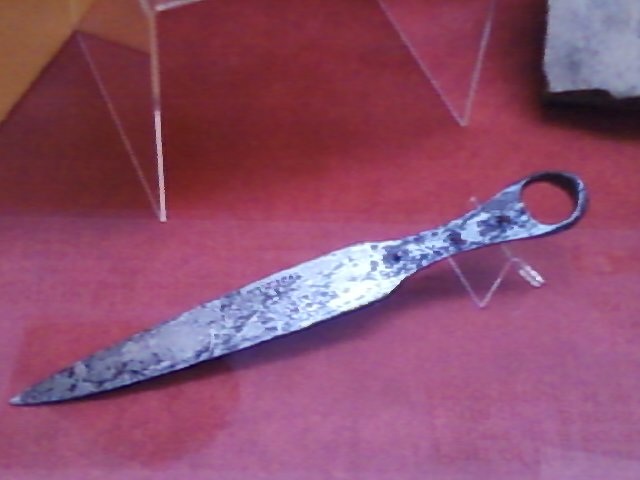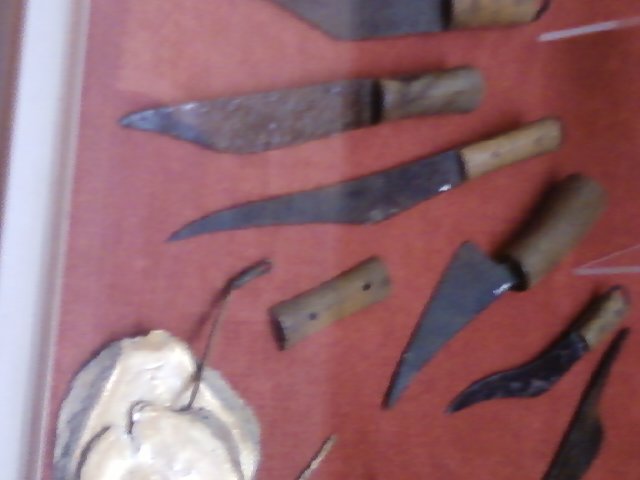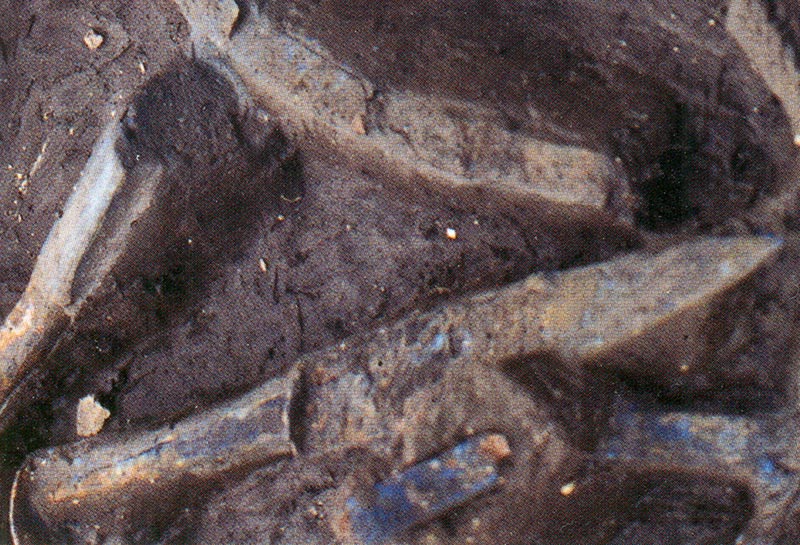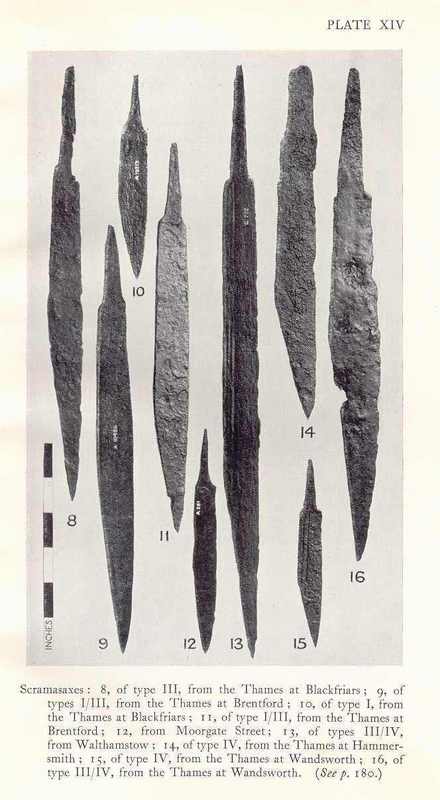| Author |
Message |
|
Dean Whitlock
Location: Thetford, Vermont Joined: 24 Apr 2009
Posts: 26
|
 Posted: Mon 27 Apr, 2009 10:54 am Post subject: form of seax in Bernicia ca.500 AD? Posted: Mon 27 Apr, 2009 10:54 am Post subject: form of seax in Bernicia ca.500 AD? |
 |
|
Hello,
I'm researching for a book idea. (I write young adult fantasy and try to be historically accurate.) Bernicia, the northern part of Northumbria, was just being invaded/settled by the Anglo-Saxons (primarily Angles) in the period 450-500 AD. Can anyone give me an idea of the shape and size of the typical seax in use by those peoples at that time? Was the angle-backed seax developed by then? Were blades much longer than 10 inches by then? Would they tend to be straight-edged or curved?
Thanks very much,
Dean
|
|
   |
 |
|
Jeroen Zuiderwijk
Industry Professional
|
 Posted: Tue 28 Apr, 2009 4:57 am Post subject: Re: form of seax in Bernicia ca.500 AD? Posted: Tue 28 Apr, 2009 4:57 am Post subject: Re: form of seax in Bernicia ca.500 AD? |
 |
|
| Dean Whitlock wrote: | Hello,
I'm researching for a book idea. (I write young adult fantasy and try to be historically accurate.) Bernicia, the northern part of Northumbria, was just being invaded/settled by the Anglo-Saxons (primarily Angles) in the period 450-500 AD. Can anyone give me an idea of the shape and size of the typical seax in use by those peoples at that time? Was the angle-backed seax developed by then? Were blades much longer than 10 inches by then? Would they tend to be straight-edged or curved?
Thanks very much,
Dean |
There weren't any real saxes at that time that I'm aware off. Some continental royal graves come with small knives, that could be considered the beginning of saxes. But the first real saxes appear during the 6th century (on the continent, don't know any examples from the UK), generally in the form of straight backed small-saxes.
Jeroen Zuiderwijk
- Bronze age living history in the Netherlands
- Barbarian metalworking
- Museum photos
- Zip-file with information about saxes
|
|
   |
 |
|
Dean Whitlock
Location: Thetford, Vermont Joined: 24 Apr 2009
Posts: 26
|
 Posted: Tue 28 Apr, 2009 2:18 pm Post subject: Re: form of seax in Bernicia ca.500 AD? Posted: Tue 28 Apr, 2009 2:18 pm Post subject: Re: form of seax in Bernicia ca.500 AD? |
 |
|
| Jeroen Zuiderwijk wrote: | | There weren't any real saxes at that time that I'm aware off. Some continental royal graves come with small knives, that could be considered the beginning of saxes. But the first real saxes appear during the 6th century (on the continent, don't know any examples from the UK), generally in the form of straight backed small-saxes. |
Thanks, Jeroen. That certainly changes things! I would imagine that most everyone would carry some sort of utility knife, if only to eat, cut yarn, and so on. The archaeological reports that I've read indicate that most grave goods in Britain, even in the earliest period, included a knife. (Many graves had no grave goods at all, of course, and many were also cremation burials.) Do you know if there was a typical form to these small knives?
Thanks again,
Dean
|
|
   |
 |
|
Joel Chesser
|
 Posted: Tue 28 Apr, 2009 2:53 pm Post subject: Posted: Tue 28 Apr, 2009 2:53 pm Post subject: |
 |
|
Here are a couple of small knives that were excavated from the Roman site of Vindolanda on Hadrians wall in Northumbria. They may be a early by 100 years or so. I don't remember exact dates on these pieces. I thought they might help.
 Attachment: 32.33 KB Attachment: 32.33 KB

 Attachment: 31.76 KB Attachment: 31.76 KB

..." The person who dosen't have a sword should sell his coat and buy one."
- Luke 22:36
|
|
  |
 |
|
Jeroen Zuiderwijk
Industry Professional
|
 Posted: Wed 29 Apr, 2009 2:55 am Post subject: Re: form of seax in Bernicia ca.500 AD? Posted: Wed 29 Apr, 2009 2:55 am Post subject: Re: form of seax in Bernicia ca.500 AD? |
 |
|
| Dean Whitlock wrote: | | Thanks, Jeroen. That certainly changes things! I would imagine that most everyone would carry some sort of utility knife, if only to eat, cut yarn, and so on. The archaeological reports that I've read indicate that most grave goods in Britain, even in the earliest period, included a knife. (Many graves had no grave goods at all, of course, and many were also cremation burials.) Do you know if there was a typical form to these small knives? |
I've only heard about these knives, but never seen them from Britain at least. The closest I can offer are these knives from Krefeld, Germany, which should be 5th century (or potentially late 4th).


I've seen similar knives from the Netherlands as well from the same period.
Jeroen Zuiderwijk
- Bronze age living history in the Netherlands
- Barbarian metalworking
- Museum photos
- Zip-file with information about saxes
|
|
   |
 |
|
Dean Whitlock
Location: Thetford, Vermont Joined: 24 Apr 2009
Posts: 26
|
 Posted: Wed 29 Apr, 2009 9:42 am Post subject: Posted: Wed 29 Apr, 2009 9:42 am Post subject: |
 |
|
Thank you Joel and Jeroen both. The photos are very helpful. It appears that small knives then follow the same trend as now in that there are lots of styles based on utility, personal preference, and what the smith knew how to make. Do you know if the same is true for the dagger or fighting knife? I'm wondering what an Anglo-Saxon fighter of that era might have carried to supplement his spear or sword, if anything, since the seax evolved somewhat later? Interesting, though, that some of the knives in Joel's second photo are seax-like in form. I wonder, too, if they are Romano-British? Joel, did you take those pics in the museum at Vindolanda?
Thanks again,
Dean
|
|
   |
 |
|
Jeroen Zuiderwijk
Industry Professional
|
 Posted: Wed 29 Apr, 2009 3:31 pm Post subject: Posted: Wed 29 Apr, 2009 3:31 pm Post subject: |
 |
|
| Dean Whitlock wrote: | | Thank you Joel and Jeroen both. The photos are very helpful. It appears that small knives then follow the same trend as now in that there are lots of styles based on utility, personal preference, and what the smith knew how to make. Do you know if the same is true for the dagger or fighting knife? I'm wondering what an Anglo-Saxon fighter of that era might have carried to supplement his spear or sword, if anything, since the seax evolved somewhat later? |
Here's the contents of a 5th century grave from Drenthe, Netherlands, possibly Saxon territory, but I'm not sure. It includes a francisca, dart or arrowheads, remains of a sword scabbard and knife:

| Quote: | | Interesting, though, that some of the knives in Joel's second photo are seax-like in form. |
Mind that a broken back shape doesn't make a sax. The angled back shape has been in used many times from at least 1000BC onwards and is still in use today. That shape is simply there to create a knife with a certain length and width, and keeping the angle of the point large enough to give it sufficient strength. The classic broken back sax evolves around the end of the 8th century, and is in use until around the 12th century (after which identically shaped knives of smaller size remain in use).
Jeroen Zuiderwijk
- Bronze age living history in the Netherlands
- Barbarian metalworking
- Museum photos
- Zip-file with information about saxes
|
|
   |
 |
Kirk Lee Spencer

|
 Posted: Wed 29 Apr, 2009 4:48 pm Post subject: Re: form of seax in Bernicia ca.500 AD? Posted: Wed 29 Apr, 2009 4:48 pm Post subject: Re: form of seax in Bernicia ca.500 AD? |
 |
|
| Dean Whitlock wrote: | Hello,
I'm researching for a book idea. (I write young adult fantasy and try to be historically accurate.) Bernicia, the northern part of Northumbria, was just being invaded/settled by the Anglo-Saxons (primarily Angles) in the period 450-500 AD. Can anyone give me an idea of the shape and size of the typical seax in use by those peoples at that time? Was the angle-backed seax developed by then? Were blades much longer than 10 inches by then? Would they tend to be straight-edged or curved?
Thanks very much,
Dean |
Hi Dean...
And welcome to the forum! 
I found a picture of a magnificent large seax-like knife in an excavation photo from Illerup Adal. This find is about a century or more before the time you are looking at, however it may give you some ideas. It appears to be somewhere around 10-12 inches long from what I can gather from the image. The crack in the grip suggest that it may be bone.
take care
ks
 Attachment: 138.01 KB Attachment: 138.01 KB

Image detail from "Spoils of Victory: The North in the Shadow of the Roman Empire" eds. Lars Jorgensen, Birger Storgaard & Lone Gebauer Thomsen
Two swords
Lit in Edenís flame
One of iron and one of ink
To place within a bloody hand
One of God or one of man
Our souls to one of
Two eternities
|
|
  |
 |
|
Dean Whitlock
Location: Thetford, Vermont Joined: 24 Apr 2009
Posts: 26
|
 Posted: Thu 30 Apr, 2009 12:03 pm Post subject: Posted: Thu 30 Apr, 2009 12:03 pm Post subject: |
 |
|
Jeroen and Kirk,
Thanks very much, these pictures and your comments are very helpful. They make me wonder where the name "seax" originated and why. In other places I have seen photos of knives called seaxes that did not have what I would have called the typical pattern (that is, not the broken-back sax and similar). There is obviously an evolution going on over this time period.
Jeroen, it was also useful to see the dart points and francisca. If not arrowheads, what sort of darts would these be? And the francisca seems early, but I suppose a fighting ax would be appropriate to almost any age, since the ax is so prevalent a farm tool. I will have to do more research on them. They are seldom if ever found among Anglo-Saxon grave goods in England, from what I have read.
Thanks again. Your depth of knowledge and devotion to the topic is very impressive!
Dean
|
|
   |
 |
|
Jeroen Zuiderwijk
Industry Professional
|
 Posted: Fri 01 May, 2009 8:51 am Post subject: Posted: Fri 01 May, 2009 8:51 am Post subject: |
 |
|
| Dean Whitlock wrote: | Jeroen and Kirk,
Thanks very much, these pictures and your comments are very helpful. They make me wonder where the name "seax" originated and why. In other places I have seen photos of knives called seaxes that did not have what I would have called the typical pattern (that is, not the broken-back sax and similar). There is obviously an evolution going on over this time period. |
Just be careful with drawing conclusions from reproductions, as those are generally way off.
| Quote: | | Jeroen, it was also useful to see the dart points and francisca. If not arrowheads, what sort of darts would these be? |
Dunno. Not plumbata I guess, as those would have included lead weights. They could have been light throwing spears, though they're quite small for that.
| Quote: | | And the francisca seems early, but I suppose a fighting ax would be appropriate to almost any age, since the ax is so prevalent a farm tool. |
I've seen them dated to roughly 400 AD. And I remember Roman axes that are quite similar too.
Jeroen Zuiderwijk
- Bronze age living history in the Netherlands
- Barbarian metalworking
- Museum photos
- Zip-file with information about saxes
|
|
   |
 |
|
Joel Chesser
|
 Posted: Fri 01 May, 2009 9:30 am Post subject: Posted: Fri 01 May, 2009 9:30 am Post subject: |
 |
|
| Dean Whitlock wrote: | Interesting, though, that some of the knives in Joel's second photo are seax-like in form. I wonder, too, if they are Romano-British? Joel, did you take those pics in the museum at Vindolanda?
Dean |
I did, and yes I believe they are Romano-British. I also thought they looked very Seax like. I asked one of the leas archaeologists at the site about this resemblance, but i don't really recall his answer.
..." The person who dosen't have a sword should sell his coat and buy one."
- Luke 22:36
|
|
  |
 |
|
Dean Whitlock
Location: Thetford, Vermont Joined: 24 Apr 2009
Posts: 26
|
 Posted: Fri 01 May, 2009 5:46 pm Post subject: Posted: Fri 01 May, 2009 5:46 pm Post subject: |
 |
|
| Joel Chesser wrote: | | I did, and yes I believe they are Romano-British. I also thought they looked very Seax like. I asked one of the leas archaeologists at the site about this resemblance, but i don't really recall his answer. |
Wouldn't it be interesting if the English broken-backed seax developed from a Romano-British pattern, independently of the models being developed on the Continent... Since the word "seax" seems to apply to a fighting knife ranging is size from dagger to short sword and of varying blade shapes, it could be possible that it was applied to the English version more or less by default. Just conjecture, of course, that would take some serious new archaeological finds to ever confirm.
Thanks again,
Dean
|
|
   |
 |
|
Dean Whitlock
Location: Thetford, Vermont Joined: 24 Apr 2009
Posts: 26
|
 Posted: Fri 01 May, 2009 5:52 pm Post subject: Posted: Fri 01 May, 2009 5:52 pm Post subject: |
 |
|
| Jeroen Zuiderwijk wrote: | | Dunno. Not plumbata I guess, as those would have included lead weights. They could have been light throwing spears, though they're quite small for that. |
Jeroen,
Is that spear point shape typical for arrowheads in that era? It seems a little large for an arrow, but it is certainly graceful. Are there broadheads that are similar in size. Obviously I have much to learn about more than seaxes!
Thanks,
Dean
|
|
   |
 |
David Huggins

|
 Posted: Sat 02 May, 2009 6:16 am Post subject: Seax Bernicea Posted: Sat 02 May, 2009 6:16 am Post subject: Seax Bernicea |
 |
|
Hi Dean
There was a francisca found in Mound 1 at Sutton Hoo, albeit later then the 5th century. It may be possible that the narrow socketed 'dart' heads that Joroen posted may well be javelin heads as he postulated, but many A-S spear heads including long bladed ones also have very narrow sockets.
regards
Dave
and he who stands and sheds blood with us, shall be as a brother.
|
|
   |
 |
|
Dean Whitlock
Location: Thetford, Vermont Joined: 24 Apr 2009
Posts: 26
|
 Posted: Sat 02 May, 2009 4:02 pm Post subject: Re: Seax Bernicea Posted: Sat 02 May, 2009 4:02 pm Post subject: Re: Seax Bernicea |
 |
|
| David Huggins wrote: | Hi Dean
There was a francisca found in Mound 1 at Sutton Hoo, albeit later then the 5th century. It may be possible that the narrow socketed 'dart' heads that Joroen posted may well be javelin heads as he postulated, but many A-S spear heads including long bladed ones also have very narrow sockets.
regards
Dave |
Thanks for that information. I've read that the southeastern Anglo-Saxons had close connections with the Franks, as well as with Swedes. (The famous Sutton Hoo helmet may well have been of Swedish make or at least Swedish inspiration.) I wonder if the francisca found there is a result of that: a trade item, a gift?
I remember reading somewhere that some arrowheads were tanged rather than socketed. Any idea if that would apply to Anglo-Saxon arrowheads around 450-550 AD?
Thanks again,
Dean
|
|
   |
 |
David Huggins

|
 Posted: Sat 02 May, 2009 11:52 pm Post subject: Seax Bernicea Posted: Sat 02 May, 2009 11:52 pm Post subject: Seax Bernicea |
 |
|
Hi Dean,
This title 'Ancient Weapons In Britain' by Logan Thompson may of assistance to you in your research.
http://www.oxbowbooks.com/bookinfo.cfm/ID/42408//Location/Oxbow
best wishes
Dave
and he who stands and sheds blood with us, shall be as a brother.
|
|
   |
 |
|
Dean Whitlock
Location: Thetford, Vermont Joined: 24 Apr 2009
Posts: 26
|
 Posted: Sun 03 May, 2009 7:57 am Post subject: Re: Seax Bernicea Posted: Sun 03 May, 2009 7:57 am Post subject: Re: Seax Bernicea |
 |
|
Hi David,
This looks very promising! I'll see if I can find it this side of the pond. I'll also be in the UK in June and can look then.
Many thanks,
Dean
|
|
   |
 |
|
Jeroen Zuiderwijk
Industry Professional
|
 Posted: Sun 03 May, 2009 2:41 pm Post subject: Posted: Sun 03 May, 2009 2:41 pm Post subject: |
 |
|
| Dean Whitlock wrote: | | Wouldn't it be interesting if the English broken-backed seax developed from a Romano-British pattern, independently of the models being developed on the Continent... Since the word "seax" seems to apply to a fighting knife ranging is size from dagger to short sword and of varying blade shapes, it could be possible that it was applied to the English version more or less by default. Just conjecture, of course, that would take some serious new archaeological finds to ever confirm. |
That's not the case. The broken back sax developed seperately at least 4 centuries after these Roman knives went out of use. The angled back saxes are the last in the line of saxes until saxes go out of use alltogether. All saxes before have straight or round backs, both in the UK and on the continent. There is a clear transition from round backed to more and more angular backed saxes in the 8th century. Below you can see transitional examples from the UK. The broken back sax isn't unique to the UK either, they occur in the Netherlands and Germany as well.
 Attachment: 36.26 KB Attachment: 36.26 KB

Jeroen Zuiderwijk
- Bronze age living history in the Netherlands
- Barbarian metalworking
- Museum photos
- Zip-file with information about saxes
|
|
   |
 |
David Huggins

|
 Posted: Mon 04 May, 2009 2:02 am Post subject: seax Bernicea Posted: Mon 04 May, 2009 2:02 am Post subject: seax Bernicea |
 |
|
Hi Dean,
Incidently in this months issue of 'Skirmish' magazine is an article on the war bow, or more significantly arrowheads from the early medieval period and the author comments on an explanation of the importance of the socket for dating arrowheads found in the British archeological excavations.
He states that until the Vikings came to British Isles virtually all metal arrow heads made by the people of Britain had a tang behind the blade portion to fit the arrow shaft, a practice common amongst the Saxons and Romano-British, but that heads fitted with a tang were common across Europe. It is widely believed that heads with sockets found in Britain were from the Viking period and after.
Now wether the Anglo-Saxons used the bow and arrow for the specific purpose of war is another question!
best
Dave
and he who stands and sheds blood with us, shall be as a brother.
|
|
   |
 |
Robert P. Wimmers
Industry Professional

Location: Dieren, The Netherlands Joined: 24 Nov 2008
Posts: 44
|
 Posted: Mon 04 May, 2009 12:04 pm Post subject: Posted: Mon 04 May, 2009 12:04 pm Post subject: |
 |
|
Hi Dean,
There is evidence for large knives from La Tene to the middle ages. These could be as large as 10 # or over. A knife that size is great for carving a roast, slicing bread and as a (backup) weapon in a tight spot. But a shorter knife of 6 # will do all that as well. The saex as depicted quickly grew into a rather large blade, ending up near to a single edged sword. Not al that practical for mundane use. But it starts of as a pretty mundane large utilitarian knife around the time of your story. There were several shapes around at the time, some very like a modern kitchen knife, others with droppoints and long (Jeroen has a theory on weighted by pouring in pewter to set the blade in the handle) handles. So I suppose knives called saex and what I have seen refered to as Messer (which is german plural for a knife) are generally fighting knives, good for slashing.
There is a lot more to a fighting knife then length, mind you, balance of the knife, as any knifemaker will tell you, is really what counts. You may want to use that in your story, the feel of a knife is very important. This makes smithing and grinding a proper fighting knife an art. The need for balance becomes less as the movements become less subtile, which is the case in plain slashing like with a machete. As the knife gets bigger, there will be more weight in the forward portion of the blade anyway.
|
|
  |
 |
|
|
You cannot post new topics in this forum
You cannot reply to topics in this forum
You cannot edit your posts in this forum
You cannot delete your posts in this forum
You cannot vote in polls in this forum
You cannot attach files in this forum
You can download files in this forum
|
All contents © Copyright 2003-2025 myArmoury.com — All rights reserved
Discussion forums powered by phpBB © The phpBB Group
Switch to the Basic Low-bandwidth Version of the forum
|

